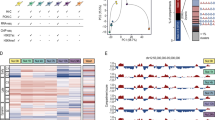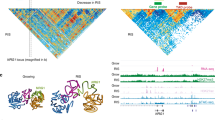Abstract
The F-box-containing protein Skp2 plays a critical role in coordinating the G1/S transition and progression through the S phase of the mammalian cell cycle. Skp2 is overexpressed in a broad spectrum of human cancers and the expression level correlates with tumor malignancy. However, the Skp2 gene is neither amplified nor rearranged in most human cancers and the underlying mechanism of Skp2 overexpression remains poorly understood. We show here that the Skp2 gene contains a functional E2F response element (hSRE2). Ectopic expression of E2F1 induces expression of the endogenous Skp2 gene in human fibroblast cells, whereas antisense-mediated knockdown of E2F1 in human tumor cell lines reduces expression of endogenous Skp2 gene. The hSRE2 element not only participates in activation of Skp2 promoter function during normal cell cycle progression into S phase, it is also required for the high-level Skp2 gene expression in many human tumor cell lines. These results reveal Skp2 as a novel target for E2F regulation that is disrupted in several human tumor cell lines.
This is a preview of subscription content, access via your institution
Access options
Subscribe to this journal
Receive 50 print issues and online access
$259.00 per year
only $5.18 per issue
Buy this article
- Purchase on Springer Link
- Instant access to full article PDF
Prices may be subject to local taxes which are calculated during checkout








Similar content being viewed by others
Accession codes
References
Amati B . (2004). Proc Natl Acad Sci USA 101: 8843–8844.
Ausubel FM, Brent R, Kingston RE, Moore DD, Seidman JG, Smith JA et al. (eds). (1990). Current Protocols in Molecular Biology (Green and Siley-Interscience, New York), Vol. 1.
Bai C, Sen P, Hofmann K, Ma L, Goebl M, Harper JW et al. (1996). Cell 86: 263–274.
Bashir T, Dorrello NV, Amador V, Guardavaccaro D, Pagano M . (2004). Nature 428: 190–193.
Bashir T, Pagano M . (2004). Cell Cycle 3: 850–852.
Bhattacharya S, Garriga J, Calbo J, Yong T, Haines DS, Grana X . (2003). Oncogene 22: 2443–2451.
Blin N, Stafford DW . (1976). Nucleic Acid Res 3: 2303–2307.
Bloom J, Pagano M . (2003). Semin Cancer Biol 13: 41–47.
Bornstein G, Bloom J, Sitry-Shevah D, Nakayama K, Pagano M, Hershko A . (2003). J Biol Chem 278: 25752–25757.
Cao Y, Wang C . (2000). J Biol Chem 275: 9854–9862.
Carrano AC, Eytan E, Hershko A, Pagano M . (1999). Nat Cell Biol 1: 193–199.
Carrano AC, Pagano M . (2001). J Cell Biol 153: 1381–1390.
Ciechanover A, Schwartz AL . (2004). Biochim Biophys Acta 1695: 3–17.
Coe BP, Henderson LJ, Garnis C, Tsao MS, Gazdar AF, Minna J et al. (2005). Genes Chromosomes Cancer 42: 308–313.
Deshaies RJ . (1999). Annu Rev Cell Dev Biol 15: 435–467.
Devoto SH, Mudryj M, Pines J, Hunter T, Nevins JR . (1992). Cell 68: 167–176.
Dow R, Hendley J, Pirkmaier A, Musgrove EA, Germain D . (2001). J Biol Chem 276: 45945–45951.
Dowen SE, Neutze DM, Pett MR, Cottage A, Stern P, Coleman N et al. (2003). Oncogene 22: 2531–2540.
Dyson N . (1998). Genes Dev 12: 2245–2262.
Frolov MV, Dyson NJ . (2004). J Cell Sci 117: 2173–2181.
Gstaiger M, Jordan R, Lim M, Catzavelos C, Mestan J, Slingerland J et al. (2001). Proc Natl Acad Sci USA 98: 5043–5048.
Helin K, Harlow E, Fattaey A . (1993). Mol Cell Biol 13: 6501–6508.
Hershko A, Ciechanover A . (1998). Annu Rev Biochem 67: 425–479.
Imaki H, Nakayama K, Delehouzee S, Handa H, Kitagawa M, Kamura T et al. (2003). Cancer Res 63: 4607–4613.
Jin J, Harper JW . (2003). Cancer Cell 3: 517–518.
Kamura T, Hara T, Kotoshiba S, Yada M, Ishida N, Imaki H et al. (2003). Proc Natl Acad Sci USA 100: 10231–10236.
Kel AE, Kel-Margoulis OV, Farnham PJ, Bartley SM, Wingender E, Zhang MQ . (2001). J Mol Biol 309: 99–120.
Kim SY, Herbst A, Tworkowski KA, Salghetti SE, Tansey WP . (2003). Mol Cell 11: 1177–1188.
Kipreos ET, Pagano M . (2000). Genome Biol 1: REVIEWS3002.
Koepp DM, Harper JW, Elledge SJ . (1999). Cell 97: 431–434.
Koga H, Harada M, Ohtsubo M, Shishido S, Kumemura H, Hanada S et al. (2003). Hepatology 37: 1086–1096.
Koziczak M, Krek W, Nagamine Y . (2000). Mol Cell Biol 20: 2014–2022.
Kurland JF, Tansey WP . (2004). Cancer Cell 5: 305–306.
Latres E, Chiarle R, Schulman BA, Pavletich NP, Pellicer A, Inghirami G et al. (2001). Proc Natl Acad Sci USA 98: 2515–2520.
Lees E, Faha B, Dulic V, Reed SI, Harlow E . (1992). Genes Dev 6: 1874–1885.
Li X, Zhao Q, Liao R, Sun P, Wu X . (2003). J Biol Chem 278: 30854–30858.
Marti A, Wirbelauer C, Scheffner M, Krek W . (1999). Nat Cell Biol 1: 14–19.
Mendez J, Zou-Yang XH, Kim SY, Hidaka M, Tansey WP, Stillman B . (2002). Mol Cell 9: 481–491.
Mercola M, Goverman J, Mirell C, Calame K . (1985). Science 227: 266–270.
Muller H, Bracken AP, Vernell R, Moroni MC, Christians F, Grassilli E et al. (2001). Genes Dev 15: 267–285.
Nakayama K, Nagahama H, Minamishima YA, Matsumoto M, Nakamichi I, Kitagawa K et al. (2000). EMBO J 19: 2069–2081.
Nakayama K, Nagahama H, Minamishima YA, Miyake S, Ishida N, Hatakeyama S et al. (2004). Dev Cell 6: 661–672.
Ohta T, Xiong Y . (2001). Cancer Res 61: 1347–1353.
Oliveira AM, Okuno SH, Nascimento AG, Lloyd RV . (2003). J Clin Oncol 21: 722–727.
Pickart CM, Eddins MJ . (2004). Biochim Biophys Acta 1695: 55–72.
Qin XQ, Livingston DM, Ewen M, Sellers WR, Arany Z, Kaelin Jr WG . (1995). Mol Cell Biol 15: 742–755.
Ren B, Cam H, Takahashi Y, Volkert T, Terragni J, Young RA et al. (2002). Genes Dev 16: 245–256.
Ross JF, Naar A, Cam H, Gregory R, Dynlacht BD . (2001). Genes Dev 15: 392–397.
Simile MM, De Miglio MR, Muroni MR, Frau M, Asara G, Serra S et al. (2004). Carcinogenesis 25: 333–341.
Smith EJ, Leone G, DeGregori J, Jakoi L, Nevins JR . (1996). Mol Cell Biol 16: 6965–6976.
Sutterluty H, Chatelain E, Marti A, Wirbelauer C, Senften M, Muller U et al. (1999). Nat Cell Biol 1: 207–214.
Tedesco D, Lukas J, Reed SI . (2002). Genes Dev 16: 2946–2957.
Tsvetkov LM, Yeh KH, Lee SJ, Sun H, Zhang H . (1999). Curr Biol 9: 661–664.
Vernell R, Helin K, Muller H . (2003). J Biol Chem 278: 46124–46137.
von der Lehr N, Johansson S, Wu S, Bahram F, Castell A, Cetinkaya C et al. (2003). Mol Cell 11: 1189–1200.
Wei W, Ayad NG, Wan Y, Zhang GJ, Kirschner MW, Kaelin Jr WG . (2004). Nature 428: 194–198.
Weinmann AS, Bartley SM, Zhang T, Zhang MQ, Farnham PJ . (2001). Mol Cell Biol 21: 6820–6832.
Weinmann AS, Yan PS, Oberley MJ, Huang TH, Farnham PJ . (2002). Genes Dev 16: 235–244.
Wells J, Graveel CR, Bartley SM, Madore SJ, Farnham PJ . (2002). Proc Natl Acad Sci USA 99: 3890–3895.
Willems AR, Schwab M, Tyers M . (2004). Biochim Biophys Acta 1695: 133–170.
Wirbelauer C, Sutterluty H, Blondel M, Gstaiger M, Peter M, Reymond F et al. (2000). EMBO J 19: 5362–5375.
Yeh KH, Kondo T, Zheng J, Tsvetkov LM, Blair J, Zhang H . (2001). Biochem Biophys Res Commun 281: 884–890.
Yokoi S, Yasui K, Mori M, Iizasa T, Fujisawa T, Inazawa J . (2004). Am J Pathol 165: 175–180.
Zhang H, Kobayashi R, Galaktionov K, Beach D . (1995). Cell 82: 915–925.
Zheng N, Schulman BA, Song L, Miller JJ, Jeffrey PD, Wang P et al. (2002). Nature 416: 703–709.
Acknowledgements
We thank Drs Reed Graves, Peter Tontonoz, and Charles Stiles for their critical review of this manuscript. We also like to thank Ms Galina Grechkina for her technical support in EMSA analysis. The work is supported by grant from NIH (CA074907).
Author information
Authors and Affiliations
Corresponding author
Rights and permissions
About this article
Cite this article
Zhang, L., Wang, C. F-box protein Skp2: a novel transcriptional target of E2F. Oncogene 25, 2615–2627 (2006). https://doi.org/10.1038/sj.onc.1209286
Received:
Revised:
Accepted:
Published:
Issue Date:
DOI: https://doi.org/10.1038/sj.onc.1209286
Keywords
This article is cited by
-
LSD1 promotes S-phase entry and tumorigenesis via chromatin co-occupation with E2F1 and selective H3K9 demethylation
Oncogene (2018)
-
Phosphorylation by mTORC1 stablizes Skp2 and regulates its oncogenic function in gastric cancer
Molecular Cancer (2017)
-
Simvastatin-induced cell cycle arrest through inhibition of STAT3/SKP2 axis and activation of AMPK to promote p27 and p21 accumulation in hepatocellular carcinoma cells
Cell Death & Disease (2017)
-
p27T187A knockin identifies Skp2/Cks1 pocket inhibitors for advanced prostate cancer
Oncogene (2017)
-
LXR activation causes G1/S arrest through inhibiting SKP2 expression in MIN6 pancreatic beta cells
Endocrine (2016)



